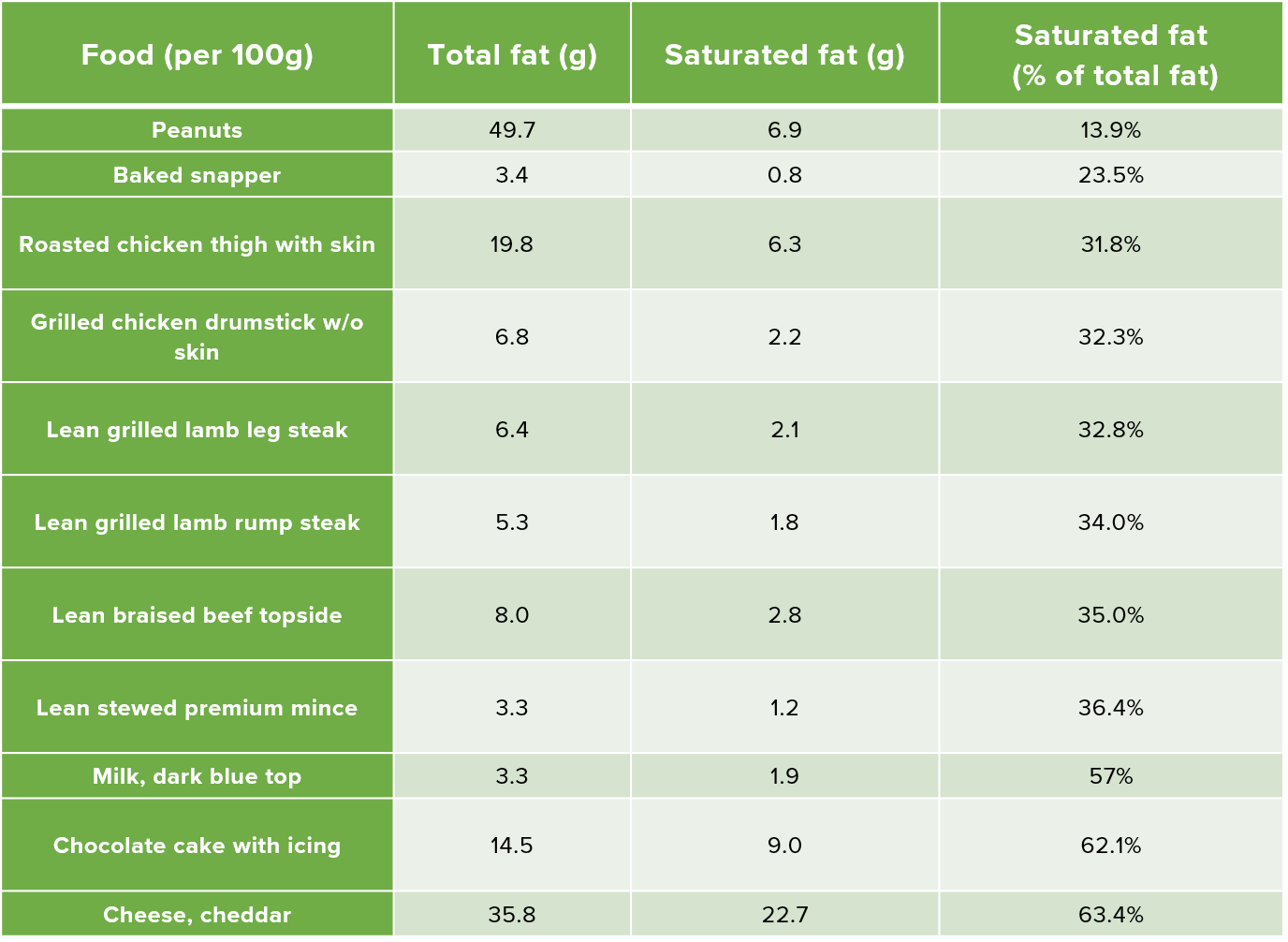Fat in food is usually a combination of saturated, polyunsaturated and monounsaturated. Although many people perceive animal fat to be totally saturated fat, this is not true. Beef and lamb fat includes polyunsaturated and saturated fat with a good proportion of monounsaturated fat.
It is important to remember we need to eat some dietary fat as it provides essential fatty acids and is required for the absorption of fat-soluble vitamins A, D, E and K as well as other fat-soluble nutrients such as lycopene in tomatoes.
Lean beef and lamb actually contribute 9% of healthy monounsaturated fat to the New Zealand diet (more than from olive oil) and only 8% of the saturated fat eaten by New Zealanders.
Key facts
Dietary fat plays an important role in how our bodies function
A healthy diet should be made up of approximately 30% fat
Fat is a concentrated source of energy. One gram of fat provides 37 kilojoules (kJ) or 9 calories (kcal). In comparison, one gram of protein provides 17kJ (4 kcal) and a gram of carbohydrate provides 16kJ (4kcal).
Types of fat in beef and lamb
What about meat and cholesterol?
Cholesterol is a type of fat found in many animal products, but is also made by the body. We need a little bit of cholesterol to maintain good bodily function, however too much can be detrimental to heart health.
Moderate amounts of cholesterol are found in meat, poultry, some fish, whole milk and cheese. It is well-known too much saturated fat in the diet can increase the negative type of cholesterol in our bodies. However, lean beef and lamb can be included in a diet designed to lower blood cholesterol. The Ministry of Health and the World Cancer Research Institute recommends that that adults can have 350-500g of cooked red meat per week as part of a healthy, balanced diet and lifestyle.
How does the fat in beef and lamb compare to other foods?
Let’s take a look at the total fat and saturated fat content of beef and lamb and other foods.
Trimmed off visible fat, lean, cooked beef contains on average only 6.6% total fat and trimmed lean, cooked lamb has about 10.5% of total fat. This is much lower in comparison to the total fat in cheddar cheese, quiche or croissants, which is around 20 to 35%.
When you compare the saturated fat content of commonly eaten foods, beef and lamb only contributes to 7.3% of the total saturated fat in the New Zealand diet. We get most of our saturated fat from other foods, including dairy products and baked products.
In general, saturated fat should be no more than 10% of your daily calories. The amount of saturated fat in beef and lamb, as well as the small contribution of beef and lamb’s saturated fat in the New Zealand diet, suggests that there is no reason for concern if you are eating it in moderation as part of a well-balanced diet full of wholegrains, fruits and vegetables.
What has the beef and lamb industry done to reduce saturated fat in the diets of New Zealanders?
Since the introduction of the New Zealand Beef and Lamb Quality Mark in 1997, trimming standards by butchers has resulted in 30% less total fat and 65% less saturated fat in the meat supply.
The healthiest way to enjoy beef and lamb
Look out for lean cuts of meat. The Beef and Lamb Quality Mark sticker is a great way to know you are buying meats with minimal fat (trimmed to a maximum 5mm of visible fat) or no more than 10% total fat in mince
For fatty cuts of meat trim off and discard visible fat from meat before eating
When cooking with fattier cuts of meat (e.g. neck chops in a casserole) allow the meat dish to cool then remove and discard any visible fat from the top before reheating.
Cook beef and lamb in minimal oil (e.g. canola oil, olive oil, rice bran oil)
Enjoy alongside seasonal vegetables
References
Den Hartigh, L.J. (2019). Conjugated linoleic acid effects of cancer, obesity and atherosclerosis: A review of pre-clinical and human trials with current perspectives. Nutrients. 11 (2).
Knight, T.W. (2003). Factors affecting the variation in fatty acid concentrations in lean beef from grass-fed cattle in New Zealand and the implications for human health. New Zealand Journal of Agricultural Research. 46 (2). 83-95.
Knight, T.W., Morris, C.A., Purchas, R.W., Agnew, M. (2003). Conjugaged linoleic and trans-vaccenic acids in grass-fed beef and lamb. Proceedings of the New Zealand Society of Animal Production. 63. 21-24.
Laugesen, M. (2005). Decreased red meat for consumption in New Zealand: 1995-2002. New Zealand Medical Journal. 118 (1226), 1751-61.
Ministry of Health. (2015). Eating and Activity Guidelines for Adults. Wellington, New Zealand.
National Health and Medical Research Council. (2006). Nutrient Reference Values for Australia and New Zealand. Canberra, ACT.Laugesen M. 2005. Decreased red meat for consumption in New Zealand: 1995-2002. NZ Med J, 118 (1226): 1751-61.
Plant and Food Research and Ministry of Health. (2016). The Concise New Zealand Food Composition Tables. 12th edition. Wellington, New Zealand.
Salminen, I., Mutanen, M., Jauhianen, M., Aro, A. (1998). Dietary trans fatty acids increase conjugated linoleic acid levels in human serum. Journal of Nutrition Biochemistry. 9, 93-98.
Turpeinen, A.M. (2002). Bioconversion of vaccenic acid to conjugated linoleic acid in humans. American Journal of Clinical Nutrition. 76, 504-410.
University of Otago and Ministry of Health. (2011). A focus on nutrition: Key findings of the 2008/9 New Zealand Adult Nutrition Survey. Wellington, New Zealand.
Whitney, E., Rolfes, S.R., Crowe, T., Cameron-Smith, D., Walsh, A. (2011). Understanding Nutrition: Australian and New Zealand Edition. Victoria, Australia.
World Health Organisation. (2018). Healthy Diet. Retrieved from https://www.who.int/news-room/fact-sheets/detail/healthy-diet
World Cancer Research Fund Cancer Prevention. (2018). Recommendation on Meat. (2018). Retrieved from https://www.wcrf.org/int/research-we-fund/cancer-prevention-recommendations/animal-foods





